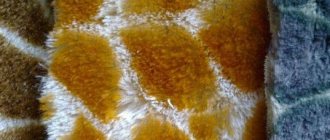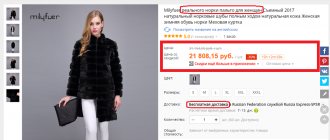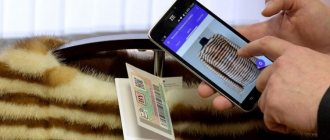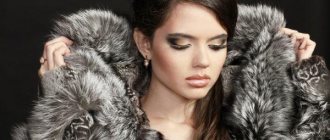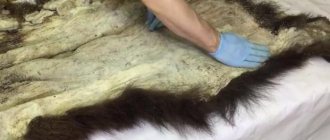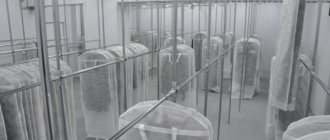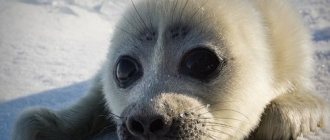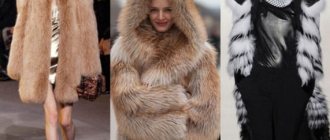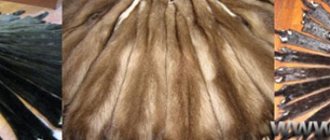Skin dressing is one of the first types of crafts mastered by man. This skill is very useful for modern people. Hunters are happy to keep the skins of killed trophies. People purposefully raise and slaughter fur-bearing animals for the sake of obtaining leather and fur. In agriculture, animal skins are processed on a large scale. Knowledge and practice in dressing skins at home will allow you to obtain high-quality raw materials for subsequent processing - sewing clothes, bags and hats, making accessories and shoes, forming stuffed animals and dummies, creating decorative elements.
Primary processing of hides
The choice of dressing technology depends on the species, lifestyle and physiological state of the animal, the type and quality of fur, age, gender and many other factors. Improper primary processing reduces the quality of leather and fur raw materials and shortens their shelf life.
The mature fur is lush and shiny, with a thick, uniform undercoat. The hair should be elastic and even, with a well-developed spine, and not fall out.
Before fur dressing begins, the animal's hair should be carefully examined. Dirt and blood are washed off using a rag or gauze soaked in warm water and laundry soap. Tangled and matted areas of fur are usually combed with a special brush. The skin must be removed carefully, avoiding cuts and tears. It is advisable to preserve the head, paws and tail.
Soaking
The next stage of dressing the skin is to soak it. For 1 kg of trophy it is worth preparing about 8 liters of solution. Furacilin and salt will prevent the growth of bacteria in the solution. The detergent removes dirt and softens. Before laying the skins, the solution must be moved very well.
For skins with short fur, you can use a little less solution, but for long pile, on the contrary, you need more liquid so that the fur does not get tangled. Do not try to straighten dry skins before soaking, otherwise they may break. The soaking process takes quite a long time. Periodically, the skins need to be stirred a little. If they are very dry, then they need to be taken out and straightened. Depending on the initial condition of the skins, the solution should be changed several times to a new one. Steamed skins (only removed) and soaked in salt should be soaked for about 2 days; well-dried skins should be soaked for at least three days. As soon as, with little effort, the hairs pop out of the skin along with the bulbs, the process can be considered complete. The skin needs to be squeezed out well.
Stages of skin and fur dressing
The removed skin is degreased and dried. Degreasing is the process of removing all subcutaneous fat. It is carried out manually using special tools over the frozen fat layer. Raw skins are straightened, giving them the correct shape and symmetry, and then dried under certain conditions - high humidity and temperature, good air exchange.
To avoid staining your fur and hands with grease, experts recommend sprinkling your work area and skins with fine sawdust.
Tanning hides at home consists of nine mandatory steps:
- Soaking. Initially, the skins are soaked for 24 hours in a concentrated saline solution. For 1 liter of water at room temperature you will need 4 level tablespoons of salt. After soaking, they are turned inside out and squeezed out.
- Fleshment. A machine for tanning skins will help you remove the flesh efficiently and quickly. The flesh is the subcutaneous fat layer of animals; it is removed with a blunt knife with a wide blade in the direction from the tail to the head.
- Secondary degreasing. At this stage, the skin is washed in a foamy solution of laundry soap. The temperature of the liquid should not exceed 25°. You can soak the skins in a soap solution for 20-30 minutes. Next, they are thoroughly rinsed in clean cold water, wrung out and turned inside out.
- Pickling or pickling. A solution for dressing skins is prepared from 2 tablespoons of vinegar essence, 4 level tablespoons of salt and 1 liter of water. The solution temperature is within 18-23°. The skins, turned inside out, are immersed in the liquid and left for several hours, stirring occasionally. For thin skins, the soaking time is 6 hours, for medium-thick skins - 8-10 hours, thick skins are soaked in pickel for more than 12 hours.
- Endurance under pressure. During pickling, organic fat and collagen fibers are destroyed in the skin tissue. After pickling, the skins are squeezed out by hand, folded 2 or 3 times and placed under pressure. Thin skins are kept under pressure for 3-4 hours, medium-thick skins - about 5 hours, thick - 6-8 hours.
- Drying. The skins are dried at room temperature away from heat sources, with the fur facing inward. For drying, special devices are used - straighteners. You can stretch the skin on a sheet of plywood. Periodically, while the skin remains wet, it is removed from the stretch and kneaded by hand.
- Tanning. Tannins restore the structure of collagen fibers. After the procedure, the skin becomes softer and more elastic, does not tear or crumble. As a tanning agent, you can use a thick infusion of oak or willow bark (take half a liter of crushed dry bark for 1 liter of water). The bark is poured into water, brought to a boil and boiled for 10-15 minutes, then infused for one day. The infusion is filtered through cheesecloth and applied to the flesh with a brush. Next, the skin is dried and crushed.
- Zhirovka. For fattening at home, a special fat emulsion is prepared. In 300 ml of warm water you need to dissolve 50 grams of soap, 50 grams of fish oil, 10 drops of ammonia, cool the solution and add another 500 ml of water. All components are thoroughly mixed and carefully, so as not to get on the fur, applied to the skin using a brush from the flesh side. The treated skins are dried at room temperature.
- Finishing processing. Finally, the skins are crushed using pumice or fine-grained sandpaper, running it along the flesh in the direction from head to tail. If necessary, stretch the skin and shake it. Now it is ready for further work - cutting, gluing or sewing.
Preparation
During the processing of the hide, its area is reduced by approximately 20%. It is best to start dressing immediately after removal, but this is not always possible. Most often, hunters start this after the end of the season, and before that they store the material in a dry, well-ventilated area. You need to prepare the necessary equipment for tanning the skin. This is a long, flat surface that will allow the trophy to spread out nicely. It is also important to prepare gloves, ingredients for solutions, a container for soaking, scrapers and a brush. First you need to soak the skin. To do this, prepare a container and clean water. You need to mix a solution based on 5 liters of water, 250 g of salt, 2.5 g of any detergent, 3 furatsilin tablets.
Popular leather dressing recipes
The fermentation procedure is considered a classic option for tanning hides, after which the material becomes strong and elastic. Alum for tanning hides is prepared according to different recipes, using ingredients of natural and artificial origin - flour, malt, rock salt, soda, acids, fermented milk products. The acid pickling procedure is an alternative to traditional fermentation. To prepare pickel, acetic acid, salt and water are usually used. Instead of vinegar, you can use sulfuric or boric acid.
Dressing must be done with fresh skin. If the work needs to be postponed, then the skin can be salted, generously rubbed with salt, frozen or dried.
Recipe for tanning skins at home:
- If the skin is dried, then it is first necessary to unwind it, that is, soak it in a special solution (1 liter of water + 1 tablespoon of salt + ½ tablet of furatsilin + ½ teaspoon of vinegar). The skin must be completely placed in the solution, so it is placed under pressure.
- The moistened skin is squeezed out, stretched and flayed according to all the rules. Next, you need to wash it to finally get rid of grease and dirt. One of the popular recipes for detergent is 6 liters of water + 3 tablespoons of dishwashing liquid + 2 tbsp. spoons of rock salt + 1 teaspoon of soda. Wash with force, then rinse the skins thoroughly until the water is absolutely clean.
- For pickling, it is recommended to prepare a solution using 3 liters of water, 6 level tablespoons of salt and 1 tablespoon of vinegar essence. The skin is kept in the pikelet for several hours, then it is squeezed out and tanned.
- Tanning agent recipe - water, oak bark, 4-5 tablespoons of salt. Everything is mixed, the liquid is brought to a boil and cooked for 20-30 minutes. The finished solution is filtered, cooled to 35-38° and the skin is soaked in it for 6-9 hours in a row.
- After tanning, the liquid is squeezed out of the skin and the fur is dried. The dried skin is treated with a fat emulsion prepared from hot water, laundry soap, salt, natural fat (pork, fish, lamb) and ammonia.
- You should remove the remaining fat solution from the surface of the skin, stretch the skin on plywood and wait for it to dry. The dried skin is removed from the stretch and kneaded, that is, it is gradually rubbed between the fingers. Finally, the core can be polished with a scraper or pumice.
Dressing leather and fur is a complex, time-consuming and labor-intensive procedure. You can achieve mastery in the leather and fur business only by working and studying. Years of experience result in light, soft and flexible skins that look great, feel great and have a long service life.
An easy way to tan hides - video
Kinds
Before considering the process of tanning hides at home, it is necessary to highlight their main types. The value of the material depends on the type of animal, its age and gender. Some skins are used for making clothes and are highly valued, others are suitable for household needs. In any case, it is worth practicing dressing first on less valuable species.
The following types of cattle hides are distinguished:
- opoek - skins of calves that have not had their first molt;
- outgrowth - the skins of calves that switched to plant food;
- semi-skin - skins of animals under two years old;
- goby – skins of young gobies;
- cowhide - skins of heifers and cows;
- bull - skins of castrated bulls:
- bugai - the skins of uncastrated bulls.
Horse skins are divided into the following types:
- foal;
- marking - young individuals;
- horse meat – adults.
Goat (goat) skins also vary depending on the age of the individual. Dairy goats have soft and delicate skins. When an animal switches to solid food, the skin becomes tougher. Mature bucks have rougher, thicker skin than female goats. Goat meat is also divided into steppe and grain.
Pork skins are obtained from domestic pigs, hogs, wild boars, and boars.
We list the types of fur that are most valued when sewing clothes:
- Sable fur is considered the most expensive. Due to the high price, fur is most often used for finishing products: collars, cuffs, hood.
- Marten fur is not as soft and fluffy as sable fur, but can be a cheaper alternative.
- Fox fur has a long pile. It is beautiful and very warm. The color can vary depending on the type of fox: red, cross, polar, silver, red, gray.
- Mink fur is very popular due to its softness. Males are larger than females and have longer fur.
- The fur of the Arctic fox is long, thick and warm. Used for sewing hats and trims. The Norwegian Arctic fox has the highest quality fur.
- Raccoon fur became popular after it began to be imported from North America. It is warm and has a beautiful color. Widely used for headwear.
- Otter fur is the most wearable. It is resistant to moisture. It is most popular for men's products; for women's it is used only after plucking.
- Nutria fur is often used to make fur coats. When plucked, it is very similar to mink fur. It has many color options: golden, silver, black, white, beige, cream, smoky.
- Muskrat fur is thick and silky. Used for sewing fur coats and finishing products.
- Beaver fur is quite heavy, and therefore is considered masculine.
- Ferret fur has a golden tint. Often used for hats and finishing products.
- Chinchilla fur is expensive and lightweight. It is soft and thick. Fur is sensitive to high humidity.
- Rabbit fur is the most inexpensive. The properties of fur depend on the breed of rabbit and the type of skin.
- The fur of Astrakhan sheep is soft, short and silky.
Let's look at how to tan a skin step by step. It is necessary to strictly adhere to all solution recipes to avoid deterioration in the quality of the fur.
Layover
Pikel penetrates the skin almost immediately after getting wet. The rest of the time, the product is evenly distributed over the skin. Curing is the period that the skin will spend in the solution. It must be at least 24 hours. To speed up pickling, you can increase the amount of acid to 20 g per liter of water. But at the same time there is a chance to worsen the quality of the final result.
The process is considered complete when, when squeezed with fingers, a white stripe forms at the fold of the flesh. At the same time, it should not go away for quite a long time.
Skin cost
Many people are interested in the question of how much mink skin costs in Russia and what the price depends on. It should be said that there is no exact cost for such fur, since any mink skin will differ from each other. And its cost directly depends on a number of many factors, for example, color, size, who sells it, how high-quality the material is.
On average, the cost of one mink skin in Russia fluctuates around $50. But you should know that no matter how much the skin costs, the cost of the product will be much higher.
Share
Flesh
This process aims to remove all the meat and subcutaneous fat that remain on the skin after it is removed from the carcass. The operation is carried out on a special fleshing machine, the main working part of which is a stainless steel shaft with screw knives installed on it. The skin is positioned in such a way that the knives move from the spine line to the sides of the skin and from the tail to the neck. At the same time, all the thickening of the flesh that is on the skin is cut off. The operating principle of the machine is based on the differences in the density characteristics of the middle layer of the skin (dermis) and the top layer (mystery). The fleshing operation is quite complex and requires special attention. It is during this period that there is a high probability of spoiling the raw material, cutting off part of the flesh along with the remnants of the fabric, or even cutting through the skin. You can read more about the defects of skins here: The most common types of classification of skins of fur-bearing animals. At the end of fleshing, the skin is washed and dried to moderate humidity.
